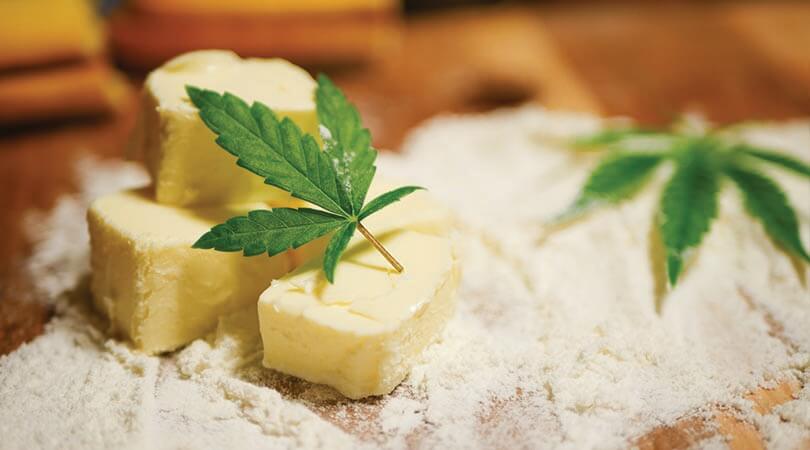Cannabis 101, Cannabis Culture, Edibles
How to Make Weedy Butter
Written and Fact Checked by: S. Zulfiqar
If you think making your cannabis-infused butter is a master chef act or if it’s the job of a top cannabis connoisseur, you’re wrong. Preparing your weedy butter is pretty simple. Although the process can be tricky, so long as you’re following the instructions and are patient, you’re good to go.
What’s the Hype around Cannabis?
There are a lot of discussions going on about the potential health benefits of cannabutter. As we speak, research is being conducted as well. According to studies, it may help in reducing chronic pains. For people that are suffering from arthritis, consumption of cannabutter showed great improvements. The same is the case with people suffering from stress or anxiety.
According to the National Cancer Institute cannabis helps in fighting cancer symptoms. It helps in other conditions like nausea, discomfort, or loss of appetite as well. Cannabutter is also great for the skin as it is rich in vitamins A, C, and E. So what we know is that it’s great for health.
Other than that, weedy butter is one of the most efficient ways of consuming weed. Plus, it is a relatively healthier alternative to smoking. Eating cannabutter is considered better than inhaling or vaping cannabis. It is also believed that after eating cannabutter, the effects last longer and are better as compared to other forms of ingestions or inhalation.
Having said that, there are various ways to consume cannabis. How we choose to have it is our own choice and will. So there’s no stopping you from consuming it as long as you’re taking it in any form.
Here’s How You Make Canna-Butter
The butter itself is a pretty decent carrier for THC but of course, there are other options as well as fatty oils like coconut oil, olive oil can also be easily infused. All you have to do is to follow the simple steps and guidelines. The article will tell you all you need to know about making legit weed butter, at home.

Ingredients
- 1 cup of butter
- 1 cup (8-10 grams) of ground cannabis
Step #1: Decarb your Weed
The first and the most important part of this recipe is called decarboxylation. It’s also referred to as ‘decarbing’ or simply ‘decarb’, this phase allows you to activate all the cannabinoids in your weed like THC and CBD, etc. In case someone doesn’t know about this process or chooses to ignore it, the results will be nothing but a disappointment. Remember how vapes work? While smoking, the heat changes TCHA into THC, and the molecules start giving euphoric effects. Decarb works the same way and while preparing CBD infused products or edibles, this process should be remembered and applied.
Over the internet, you’ll find loads of recipes where they might ask you to decarb cannabis directly i.e. by adding it to the hot butter. But the pro tip is to decarb the weed first.
Step #2: Bake it off
So the first step is to preheat your oven to 240° F. Once you’re sure that the oven has reached the required temperature, evenly place the plant on your non-stick oven tray. A useful tip is to cover the tray with some parchment paper. This will prevent them from being too sticky. Bake the buns for about 30-40 minutes.
It is important to remember that the older the drier the weed is, the less time it will require to decarb. If your weed is cured, you might want to bake it for 45ish minutes. Similarly, if it’s high grade (still wet), it might require an hour or more in the oven.
You can also preheat the oven at 300° F and the process may take about 20 minutes. But it is recommended to use a low-and-slow approach.
About every 8-12 minutes, lightly shake the tray to mix the buds so that the buds can be evenly exposed.
Step #3: Grind the Weed
Now, using a hand grinder or scissors, break apart the weed. If you don’t own a hand grinder or can’t find a pair of scissors, you can use your hands to break down the weed. Just make sure they’re fine enough (but not too fine).
Simmer and Mix the Butter
Take one cup of butter and equal parts of the water in a stockpot and let it simmer on low heat. The water will help in controlling the temperature of the butter and will save it from scorching. Wait for a while and allow the butter to properly melt.
Once the butter is melted, start adding cannabis to the pot. Keep an eye on the heat as it should not be exceeding 200° F. It should ideally be around 150-160° F. Allow the mixture to simmer for a good couple of (or 3) hours. Meanwhile, you can stir after a while so that it doesn’t burn. Also, remember that the mixture should never be boiling.
Pour into a Jar & Refrigerate
Use cheesecloth and a funnel to pour the mixture into a clean jar. Let the mixture take its time to strain freely as squeezing the cheesecloth may push what’s not required i.e. the bad-tasting plant material.
Refrigerate your jar of cannabutter and in case you see some water at the bottom of your jar, that’s just excess water. Get rid of it however you wish to but let the jar rest in the fridge for at least 2-3 hours before you remove the excess water.

Your Weedy Butter is Ready – Enjoy
There you have it. You have made your very own weedy butter at home. You can also have the wholesome butter with the snacks of your choice or can simply have a go on the butter itself. The weedy butter can be used as a substitute for regular butter. You can use it in other recipes or you can just top your pasta with it. Spread it on your toast or have it with anything in your lunch. However, you like it.
On the other hand, make sure not to overdo the situation by having way too much of it. Look out for the recommended dose of consuming cannabutter and in case you think you don’t feel so good after having it, make sure to contact your doctor or a certified professional.
Interesting reads: How to Grow Weed, The Lost Art of Wake and Bake, Weed Vape Guide
References
- TP;, B. (2019, October 2). Cannabis and cannabinoids in mood and anxiety disorders: Impact on illness onset and course, and assessment of therapeutic potential. Retrieved April 09, 2021, from https://pubmed.ncbi.nlm.nih.gov/31577377/
- G;, L. (2019, May 31). Joints for joints: Cannabinoids in the treatment of rheumatoid arthritis. Retrieved April 10, 2021, from https://pubmed.ncbi.nlm.nih.gov/30920973/









